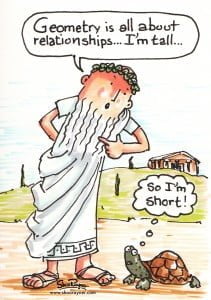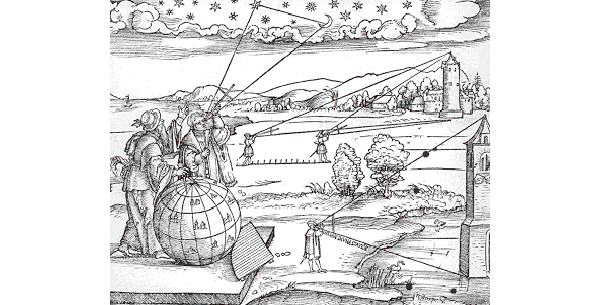Article status: Draft
Time Estimate for Reading: 20 min
Learning Objectives: Significance of Abstract Concepts and Introduction to Geometry
Effort Required: Medium
Pedagogy Model: Evolution, Formula Analysis, Inter-disciplinary
Prior Physics Concepts: displacement, velocity, acceleration, mass
Prior Math Tools: Secondary school level Arithmetic, geometry and algebra
Euclidean geometry (300 BC), could well share something in common with Galileo's law of falling bodies (1600), Newtons laws (1667), Maxwell's equations 1861), Planck's Constant (1900) and Einsteins theory of relativity (1905). The common ground is that all of science is modeled around space, time, mass and energy (also include power) and it was a collaborative effort spanning more than 2000 years to connect these concepts.
 - Euclid gives an account of how to understand the concept of 3 dimensional space (points, lines .. etc )
- Euclid gives an account of how to understand the concept of 3 dimensional space (points, lines .. etc )
- Galileo demonstrates the relationship between space and time for bodies in free fall (displacement is proportional to square of acceleration)
- Newton goes on to combine the concepts of space, time and mass (f=ma) and treats each of them as independent entities
- Maxwell sets the limit for maximum velocity (displacement/time). Determines the maximum speed of light from his wave equations and also lays the foundation for wave-particle duality
 - Planck's constant determining the minimum quanta of energy (E = hf).
- Planck's constant determining the minimum quanta of energy (E = hf).
 - Einstein introduces the concept of 4 dimensional space-time (theory of relativity) where space and time are no more independent entities. He also goes on to establish that mass and energy are mutually convertible (mass energy equivalence and the most famous equation E=mc2)
- Einstein introduces the concept of 4 dimensional space-time (theory of relativity) where space and time are no more independent entities. He also goes on to establish that mass and energy are mutually convertible (mass energy equivalence and the most famous equation E=mc2)
From Euclid to Einstein, 2200 years of rich history. Rather we would call it a game that is played with concepts of Space, Time, Mass and Energy. Euclid begins this game and established the first set of rules. The first rule is about a point. "A point is that which has no part". Well. Well.
Let us embark on a time travel to 300 BC. We had the number systems (cant believe zero and negative numbers are yet to be discovered), the Pythagoras theorem, astronomical studies and theory of music. During this period, During this period, for some of ancestors stars and planets were the gods and for some others it was numbers (considered to be perfect) that where the gods. The earth was still flat.
The evolution of rules for connect space, time, mass and energy are not over as yet. We are still in pursuit of a single unified theory which connects space, time, mass and energy. Planck's constant might take us one step closer.
We may redefine the point now based on Planck's constant. The Euclidean definition of point was for a reason that, we may mark a point with different sizes of pens. But now that we have Planck's constant and Planck Length, we may redefine the point in 3 dimensions as "A point is defined as a Sphere of radius equal to half Plank Length". That's the minimum of a point which we can mark. But i am sure, we cant mark this point on a paper made of wood. May be we could, on a paper made of dark matter or dark energy. Great. What sort of pen do we use to write on such a dark matter paper? Life gets interesting.
For those interested in numbers;
Planck's Constant = 6.62607004 × 10-34 m2 kg / s
Planck Length = 1.6 x 10-35 m or about 10-20 times the size of a proton
Planck Point = 2.1436E-105 m^3 (volume of a sphere of half the radius - 4/3*pi*R^3)
Well. A number raised to the power of -105. That should be pretty small. And people say, at this scale, quantum gravity takes over (whatever that means?) and is not Newtonian anymore. And with that, We pretty much feel like Euclid, trying to make a point. Starting allover again. Time for new game and new rules.
Foot note - Impact of Euclid and Euclidean Geometry
Time Estimate for Reading: 20 min
Learning Objectives: Significance of Abstract Concepts and Introduction to Geometry
Effort Required: Medium
Pedagogy Model: Evolution, Formula Analysis, Inter-disciplinary
Prior Physics Concepts: displacement, velocity, acceleration, mass
Prior Math Tools: Secondary school level Arithmetic, geometry and algebra
Euclidean geometry (300 BC), could well share something in common with Galileo's law of falling bodies (1600), Newtons laws (1667), Maxwell's equations 1861), Planck's Constant (1900) and Einsteins theory of relativity (1905). The common ground is that all of science is modeled around space, time, mass and energy (also include power) and it was a collaborative effort spanning more than 2000 years to connect these concepts.
 - Euclid gives an account of how to understand the concept of 3 dimensional space (points, lines .. etc )
- Euclid gives an account of how to understand the concept of 3 dimensional space (points, lines .. etc )- Galileo demonstrates the relationship between space and time for bodies in free fall (displacement is proportional to square of acceleration)
- Newton goes on to combine the concepts of space, time and mass (f=ma) and treats each of them as independent entities
- Maxwell sets the limit for maximum velocity (displacement/time). Determines the maximum speed of light from his wave equations and also lays the foundation for wave-particle duality
From Euclid to Einstein, 2200 years of rich history. Rather we would call it a game that is played with concepts of Space, Time, Mass and Energy. Euclid begins this game and established the first set of rules. The first rule is about a point. "A point is that which has no part". Well. Well.
Let us embark on a time travel to 300 BC. We had the number systems (cant believe zero and negative numbers are yet to be discovered), the Pythagoras theorem, astronomical studies and theory of music. During this period, During this period, for some of ancestors stars and planets were the gods and for some others it was numbers (considered to be perfect) that where the gods. The earth was still flat.
During this period, most of activity involved measurement of land, tracking stars and planets. There was no clear method of mathematically describing space.
Such a description had to wait till the definition of the concept called "point".
A point in geometry is a location. It has no size i.e. no width, no length and no depth. A point is shown by a dot. This definition is a physical impossibility but an abstract concept. But once, the point is accepted as an abstract concept, we could go on and define a line.
Such a description had to wait till the definition of the concept called "point".
A point in geometry is a location. It has no size i.e. no width, no length and no depth. A point is shown by a dot. This definition is a physical impossibility but an abstract concept. But once, the point is accepted as an abstract concept, we could go on and define a line.
A line is defined as a line of points that extends infinitely in two directions. It has one dimension, the length. So, a non-existent point leads to a non-existent line. On a similar note, rules for area, volume, parallel lines, angles etc could be derived.
Returning from the past, we observe this to be a case of extreme simplification (watch out! Complexity is simplicity in disguise) of geometry. It should have taken years for Euclid to arrive at the abstract concept called "point". Once "point" was defined and understood, everything else fell in place. The emphasis here is that, every subject has a core concept. once that is identified all other aspects will reveal itself.
Now we do have non-euclidean geometry for spherical and hyperbolic spaces. The Euclidean definitions still hold and just extended.
Now we do have non-euclidean geometry for spherical and hyperbolic spaces. The Euclidean definitions still hold and just extended.
The evolution of rules for connect space, time, mass and energy are not over as yet. We are still in pursuit of a single unified theory which connects space, time, mass and energy. Planck's constant might take us one step closer.
We may redefine the point now based on Planck's constant. The Euclidean definition of point was for a reason that, we may mark a point with different sizes of pens. But now that we have Planck's constant and Planck Length, we may redefine the point in 3 dimensions as "A point is defined as a Sphere of radius equal to half Plank Length". That's the minimum of a point which we can mark. But i am sure, we cant mark this point on a paper made of wood. May be we could, on a paper made of dark matter or dark energy. Great. What sort of pen do we use to write on such a dark matter paper? Life gets interesting.
For those interested in numbers;
Planck's Constant = 6.62607004 × 10-34 m2 kg / s
Planck Length = 1.6 x 10-35 m or about 10-20 times the size of a proton
Planck Point = 2.1436E-105 m^3 (volume of a sphere of half the radius - 4/3*pi*R^3)
Well. A number raised to the power of -105. That should be pretty small. And people say, at this scale, quantum gravity takes over (whatever that means?) and is not Newtonian anymore. And with that, We pretty much feel like Euclid, trying to make a point. Starting allover again. Time for new game and new rules.
Foot note - Impact of Euclid and Euclidean Geometry
No wonder, Abraham Lincoln was fascinated by this and spent two years to study Euclid's book on Elements and this is why?. He wanted to know, What does it really mean to “prove” something? How do you “demonstrate” that a person is innocent or guilty? Lincoln wanted to understand proof in a deeper way. A case where mathematics helps a lawyer. Inspiration and knowledge may come from any any source. Just that we got to be open for ideas and exploration.
On a similar note, Galileo is supposed to have spent 2 years (when he was 22 years of age) learning and teaching Elements. Probably this could have made him to convince himself to pursue mathematics and incidentally, most of his proofs (parabolic motion, law of falling bodies etc) are based on geometry. Rather higher mathematical concepts like differential and integral calculus were yet to be invented.
As much as Galileo is considered the proponent of experimental science, Euclid is considered to be proponent of deductive and logical reasoning. Let us not leave newton and Einstein out, they are the proponents of Thought Experiments.
References:
https://en.wikipedia.org/wiki/History_of_special_relativity
https://en.wikipedia.org/wiki/Planck_constant
https://en.wikipedia.org/wiki/Planck_units
https://en.wikipedia.org/wiki/Planck_units

No comments:
Post a Comment